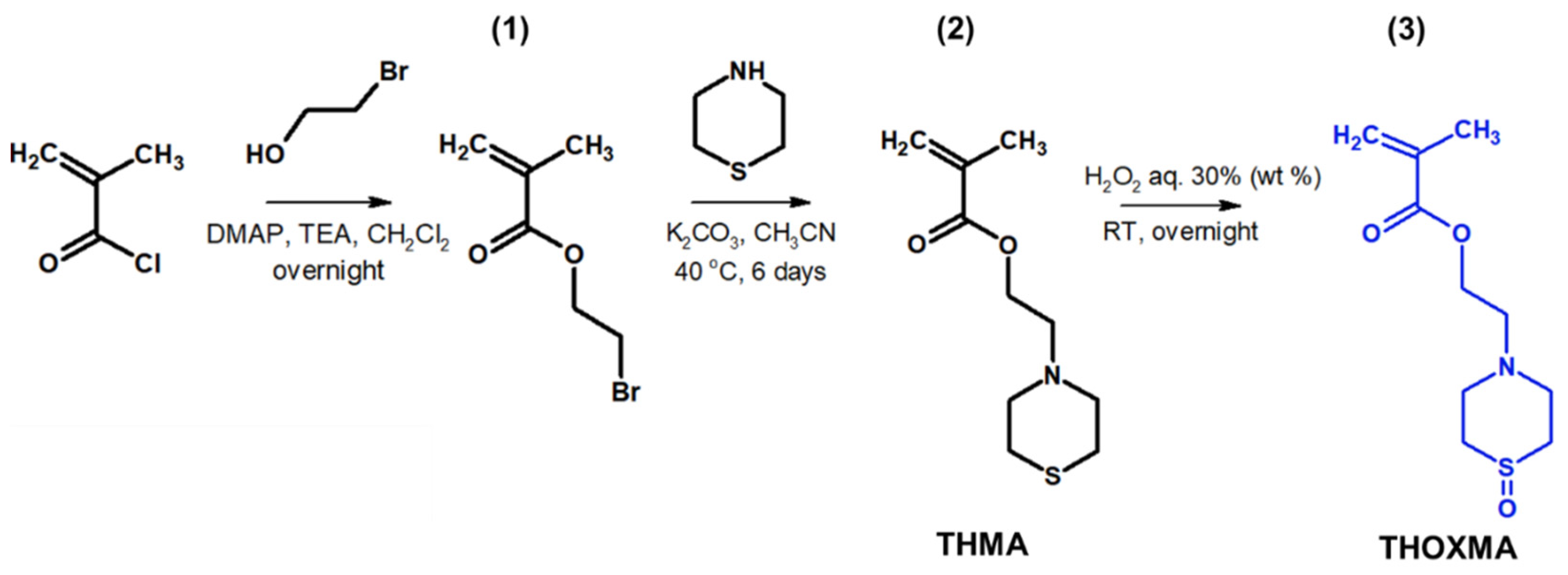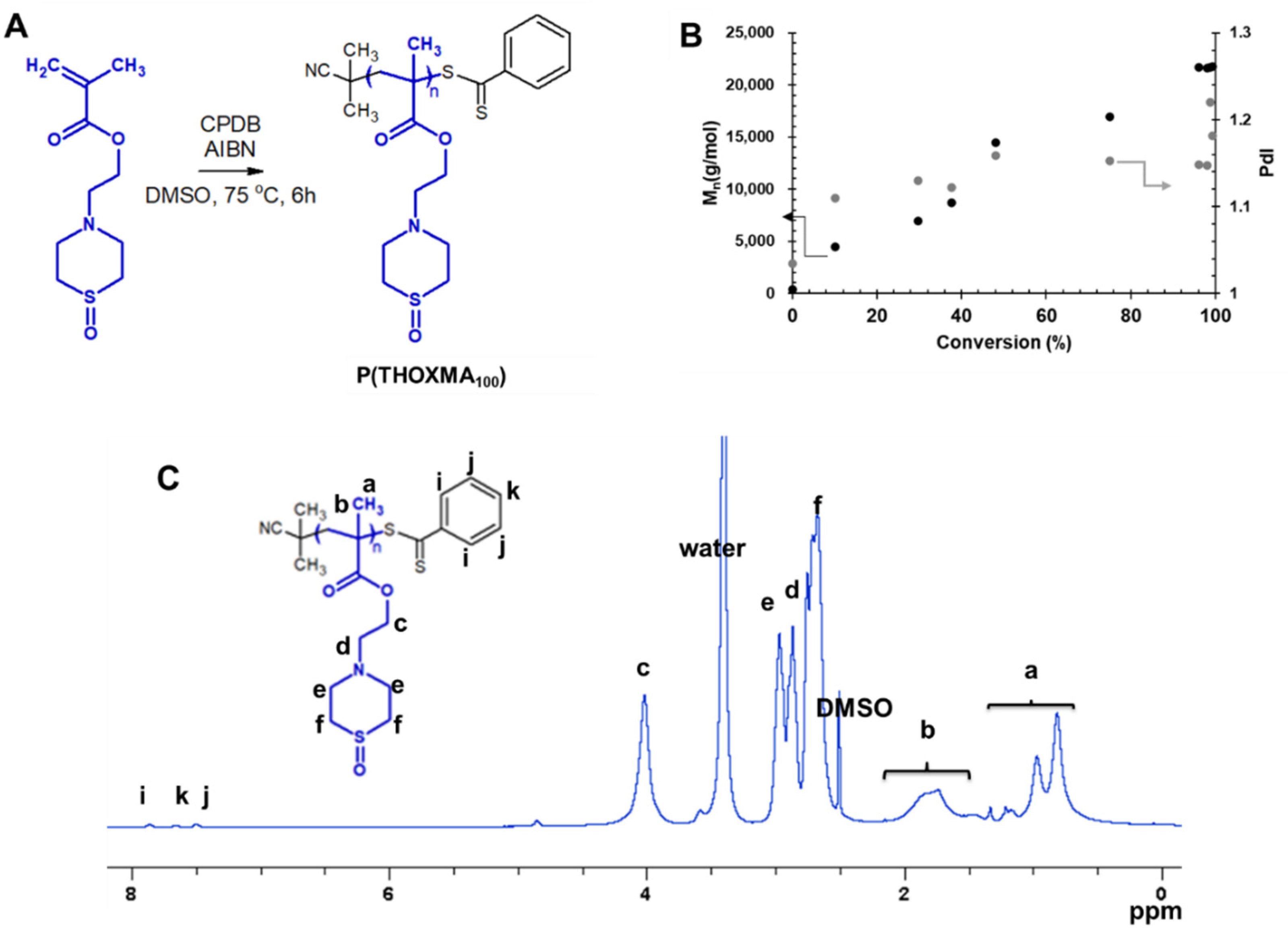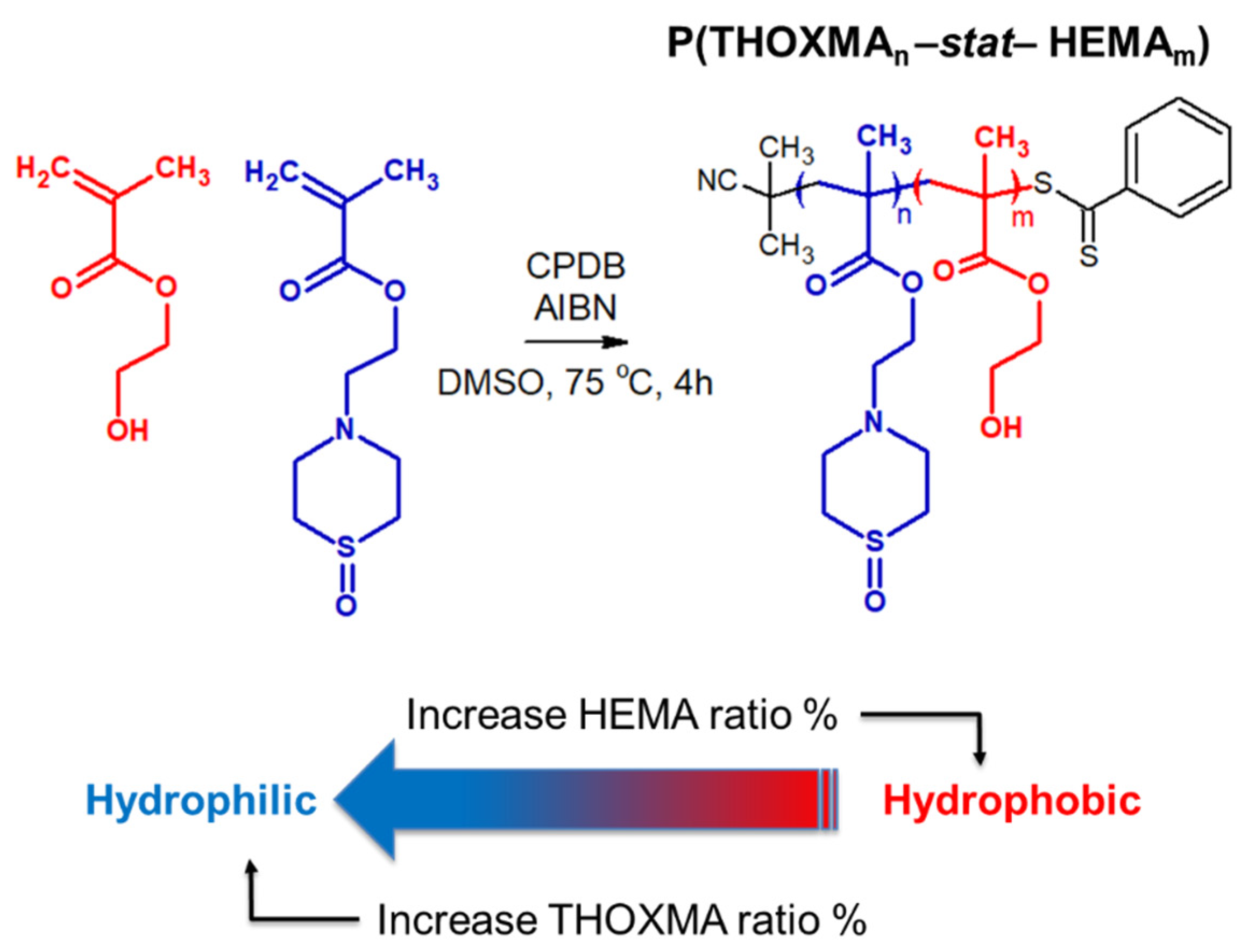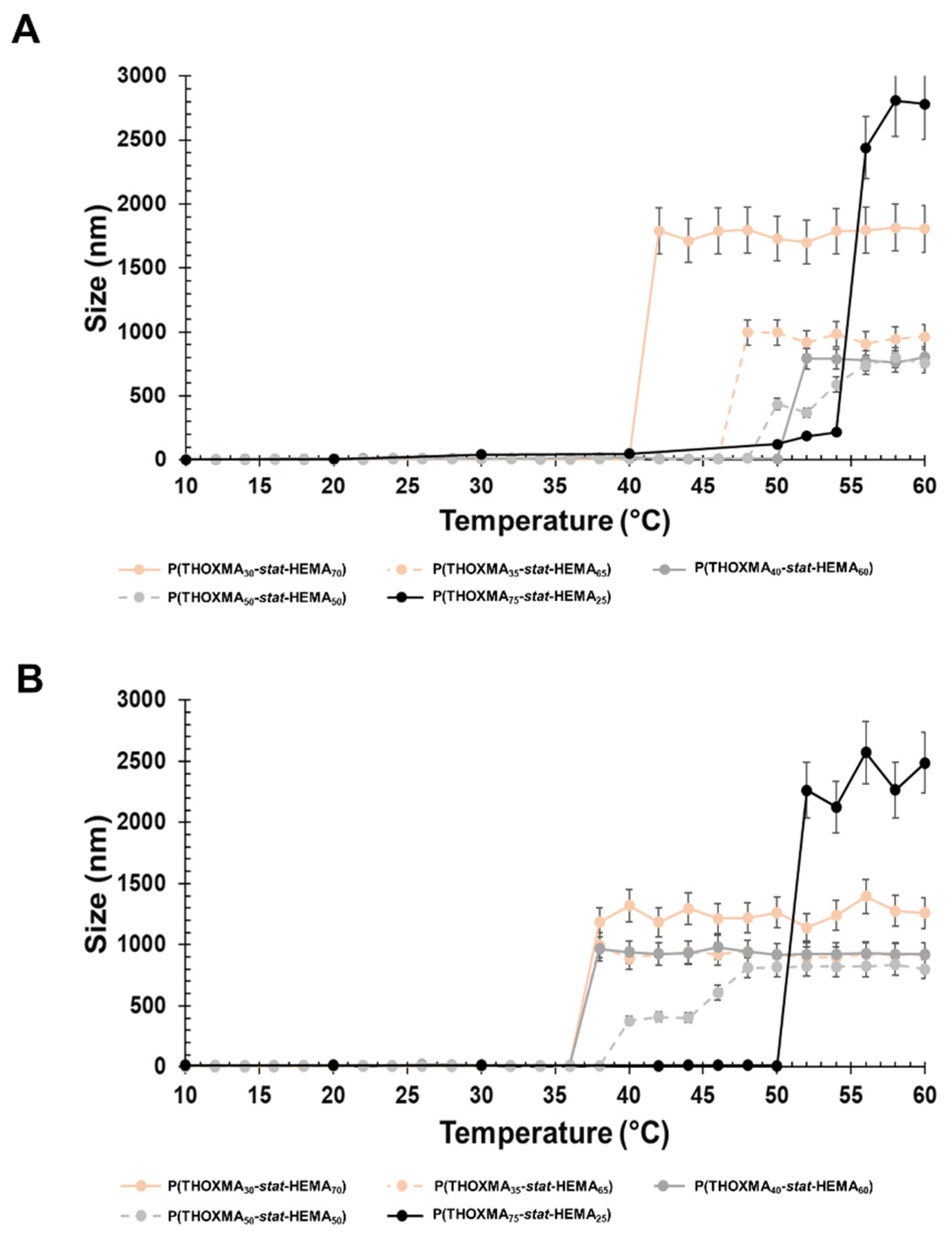Stimuli-Responsive Thiomorpholine Oxide-Derived Polymers with Tailored Hydrophilicity and Hemocompatible Properties
Abstract
:1. Introduction
2. Experimental Section
2.1. Materials
2.2. Instrumentation
2.3. Synthesis of 2-Bromoethyl Methacrylate
2.4. Synthesis of Ethylthiomorpholine Methacrylate (THMA)
2.5. Synthesis of Ethylthiomorpholine Oxyde Methacrylate (THOXMA)
2.6. Synthesis of Poly(ehylthiomorpholine oxide methacrylate) P(THOXMA)100 Homopolymer and Statistical Copolymers Poly(ethylthiomorpholine oxide methacrylate-stat-hydroxyethylmethacrylate) P(THOXMAn-stat-HEMAm) by RAFT
2.7. Determination of the pKa of the Monomers and Polymers
2.8. Evaluation of the LCST of P(THOXMA100) and P(THOXMAn-stat-HEMAm) Statistical Copolymers
2.9. Cytotoxicity Assays
2.10. Haemolysis Tests
2.11. Erythrocyte Aggregation
3. Results and Discussion
3.1. Synthesis of Monomers and Hydrophobic/Hydrophilic Polymers
3.2. Acido-Basic Properties of THOXMA and PTHOXMA
3.3. Determination of LCST
3.4. Biocompatibility of PTHOXMA
4. Conclusions
Supplementary Materials
Author Contributions
Funding
Conflicts of Interest
References
- Duncan, R.; Vicent, M.J. Polymer therapeutics-prospects for 21st century: The end of the beginning. Adv. Drug Deliv. Rev. 2013, 65, 60–70. [Google Scholar] [CrossRef] [PubMed]
- Kost, J.; Langer, R. Responsive polymeric delivery systems. Adv. Drug Deliv. Rev. 2012, 64, 327–341. [Google Scholar] [CrossRef]
- Zhang, Q.; Weber, C.; Schubert, U.S.; Hoogenboom, R. Materials Horizons Thermoresponsive polymers with lower critical solution temperature: From fundamental aspects turbidimetry conditions. Mater. Horiz. 2017, 4, 109–116. [Google Scholar] [CrossRef]
- Pasparakis, G.; Tsitsilianis, C. LCST polymers: Thermoresponsive nanostructured assemblies. Polymers 2020, 211, 123146–123206. [Google Scholar] [CrossRef]
- Ward, M.A.; Georgiou, T.K. Thermoresponsive Polymers for Biomedical Applications. Polymers 2011, 3, 1215–1242. [Google Scholar] [CrossRef] [Green Version]
- Nagase, K.; Yamato, M.; Kanazawa, H.; Okano, T. Poly(N-isopropylacrylamide)-based thermoresponsive surfaces provide new types of biomedical applications. Biomaterials 2018, 153, 27–48. [Google Scholar] [CrossRef]
- Hou, L.; Wu, P. LCST transition of PNIPAM-b-PVCL in water: Responsive segments. Soft Matter 2014, 10, 3578–3586. [Google Scholar] [CrossRef]
- Cook, M.T.; Haddow, P.; Kirton, S.B.; Mcauley, W.J. Polymers Exhibiting Lower Critical Solution Temperatures as a Route to Thermoreversible Gelators for Healthcare. Adv. Funct. Mater. 2021, 31, 2008123–2008148. [Google Scholar] [CrossRef]
- Quynh, T.M.; Yoneyamab, M.; Maki, Y.; Dobashi, T. Poly(N-isopropylacrylamide-co-hydroxyethyl methacrylate) Graft Copolymers and Their Application as Carriers for Drug Delivery System. J. Appl. Pol. Sci. 2011, 123, 2368–2376. [Google Scholar] [CrossRef]
- Zhang, X.; Zhou, L.; Zhang, X.; Dai, H. Synthesis and Solution Properties of Temperature—Sensitive Copolymers Based on NIPAM. J. Appl. Pol. Sci. 2009, 116, 1099–1105. [Google Scholar] [CrossRef]
- Kasprow, M.; Machnik, J.; Otulakowski, L.; Dworak, A.; Trzebicka, B. Thermoresponsive P(HEMA-co-OEGMA) copolymers: Synthesis, characteristics and solution behavious. RSC Adv. 2019, 9, 40966–40974. [Google Scholar] [CrossRef] [PubMed] [Green Version]
- Hao, G.; Xu, Z.P.; Li, L. Manipulating extracellular tumour pH: An effective target for cancer therapy. RSC Adv. 2018, 8, 22182–22192. [Google Scholar] [CrossRef] [PubMed] [Green Version]
- Hausig, F.; Sobotta, F.H.; Richter, F.; Harz, D.; Traeger, A.; Brendel, J.C. Correlation between Protonation of Tailor-Made Polypiperazines and Endosomal Escape for Cytosolic Protein Delivery. ACS Appl. Mater. Interfaces 2021, 13, 35233–35247. [Google Scholar] [CrossRef] [PubMed]
- Butun, V.; Kocak, G.; Tuncer, C. pH-responsive Polymers. Polym. Chem. 2016, 8, 144–176. [Google Scholar] [CrossRef]
- Xu, F.; Li, H.; Luo, Y.L.; Tang, W. Redox-Responsive Self-Assembly Micelles from Poly(N-acryloylmorpholine-block-2-acryloyloxyethyl ferrocenecarboxylate) Amphiphilic Block Copolymers as Drug Release Carriers. ACS Appl. Mater. Interfaces 2017, 9, 5181–5192. [Google Scholar] [CrossRef] [PubMed]
- Wei, M.; Gao, Y.; Li, X.; Serpe, M.J. Stimuli-responsive polymers and their applications. Polym. Chem. 2017, 8, 127–143. [Google Scholar] [CrossRef] [Green Version]
- Van Overstraeten-Schlogel, N.; Shim, Y.H.; Tevel, V.; Piel, G.; Piette, J.; Dubois, P.; Raes, M. Assessment of new biocompatible Poly(N-(morpholino) ethyl methacrylate)-based copolymers by transfection of immortalized keratinocytes. Drug Deliv. 2012, 19, 112–122. [Google Scholar] [CrossRef]
- Butun, V.; Armes, S.P.; Billingham, N.C. Synthesis and aqueous solution properties of near-monodisperse tertiary amine methacrylate homopolymers and diblock copolymers. Polymers 2001, 42, 5993–6008. [Google Scholar] [CrossRef]
- Taranejoo, S.; Liu, J.; Verma, P.; Hourigan, K. A review of the developments of characteristics of PEI derivatives for gene delivery applications. J. Appl. Polym. Sci. 2015, 42096, 2–9. [Google Scholar] [CrossRef]
- Sobotta, F.H.; Hausig, F.; Harz, D.O.; Hoeppener, S.; Schubert, U.; Brendel, J.C. Oxidation-responsive micelles by a one-pot polymerization-induced self-Assembly approach. Polym. Chem. 2018, 9, 1593–1602. [Google Scholar] [CrossRef]
- Kang, Y.; Pitto-Barry, A.; Rolph, M.; Hua, Z.; Hands-Portman, I.; Kirby, N.; O’Reilly, R. Use of complementary nucleobase-containing synthetic polymers to prepare complex self-assembled morphologies in water. Polym. Chem. 2016, 7, 2836–2846. [Google Scholar] [CrossRef] [PubMed] [Green Version]
- Samsonova, O.; Pfeiffer, C.; Hellmund, M.; Merkel, O.M.; Kissel, T. Low Molecular Weight pDMAEMA-block-pHEMA Block-Copolymers Synthesized via RAFT-Polymerization: Potential Non-Viral Gene Delivery Agents? Polymers 2011, 3, 693–718. [Google Scholar] [CrossRef]
- Hu, J.; Zhang, G.; Ge, Z.; Liu, S. Progress in Polymer Science Stimuli-responsive tertiary amine methacrylate-based block copolymers: Synthesis, supramolecular self-assembly and functional applications. Prog. Polym. Sci. 2014, 39, 1096–1143. [Google Scholar] [CrossRef]
- Funhoff, A.M.; Van Nostrum, C.; Koning, G.A.; Schuurmans-Nieuwenbroek, N.; Crommelin, D.; Hennik, W. Endosomal Escape of Polymeric Gene Delivery Complexes Is Not Always Enhanced by Polymers Buffering at Low pH. Biomacromolecules 2004, 5, 32–39. [Google Scholar] [CrossRef] [PubMed]
- Chremos, A.; Douglas, J.F. Polyelectrolyte association and solvation. J. Chem. Phys. 2018, 149, 163305–163311. [Google Scholar] [CrossRef]
- Chang, H.; Samsonova, O.; Kang, S.; Han, Y. The effect of environmental pH on polymeric transfection efficiency. Biomaterials 2012, 33, 1651–1662. [Google Scholar] [CrossRef] [Green Version]
- Zare, M.; Bigham, A.; Zare, M.; Luo, H.; Ghomi, E.R.; Ramakrishna, S. pHEMA: An Overview for Biomedical Applications. Int. J. Mol. Sci. 2021, 22, 6376. [Google Scholar] [CrossRef]
- Vasey, C.E.; Cavanagh, R.; Taresco, V.; Moloney, C.; Smith, S.; Rahman, R.; Alexander, C. Polymer Pro-Drug Nanoparticles for Sustained Release of Cytotoxic Drugs Evaluated in Patient-Derived Glioblastoma Cell Lines and In Situ Gelling Formulations. Pharmaceutics 2021, 13, 208. [Google Scholar] [CrossRef]
- Greco, I.; Molchanova, N.; Holmedal, E.; Jenssen, H. Correlation between hemolytic activity, cytotoxicity and systemic in vivo toxicity of synthetic antimicrobial peptides. Sci. Rep. 2020, 10, 13206. [Google Scholar] [CrossRef]
- Gonzales-Dominguez, I.; Grimaldi, I.; Cervera, L.; Ventosa, N.; Godia, F. Impact of physico-chemical properties of DNA/PEI complexes on transient transfection on mammalian cells. New Biotechnol. 2014, 49, 88–97. [Google Scholar] [CrossRef] [Green Version]
- Isaacs, L.; Chin, D.N.; Bowden, N.; Xia, Y.; Whitesides, G.M. Self-Assembling Systems on Scales from Nanometers to Millimeters: Design and Discovery. In Perspectives in Supramolecular Chemistry; Reinhoudt, D.N., Ed.; John Wiley & Sons Ltd.: New York, NY, USA, 2007; Volume 4, pp. 1–46. [Google Scholar]
- Eggers, S.; Fischer, B.; Abetz, V. Aqueous Solutions of Poly[2-(N-morpholino) ethyl methacrylate]: Learning about Macromolecular Aggregation Processes from a Peculiar Three-Step Thermoresponsive Behavior. Macromol. Chem. Phys. 2016, 217, 735–747. [Google Scholar] [CrossRef]
- Reschner, A.; Shim, Y.-H.; Dubois, P.; Delvenne, P.; Evrard, B.; Marcelis, L.; Moucheron, C.; Kirsch-De Mesmaeker, A.; Defrancq, E.; Raes, M.; et al. Evaluation of a New Biocompatible Poly(N-(Morpholino Ethyl Methacrylate)-Based Copolymer for the Delivery of Ruthenium Oligonucleotides, Targeting HPV16 E6 Oncogene. J. Biomed. Nanotech. 2013, 9, 1432–1440. [Google Scholar] [CrossRef] [PubMed]






| Entry | Conversion of Monomers (%) a | Experimental DP b | DPTarget c | Mn (g/mol) d | Mn (g/mol) e | Dispersity (Đ) e | |
|---|---|---|---|---|---|---|---|
| THOXMA | HEMA | ||||||
| P(THOXMA100) | 99.3 | - | 111 | 100 | 25,640 | 21,570 | 1.21 |
| P(THOXMA80-stat-HEMA20) | 95.6 | 98.1 | 80 | 100 | 16,900 | 14,100 | 1.19 |
| P(THOXMA50-stat-HEMA50) | 98 | 99 | 82 | 100 | 14,970 | 18,200 | 1.24 |
| P(THOXMA40-stat-HEMA60) | 97 | 99.5 | 81 | 100 | 14,600 | 16,100 | 1.22 |
| P(THOXMA35-stat-HEMA65) | 98.5 | 99.3 | 80 | 100 | 13,000 | 17,900 | 1.19 |
| P(THOXMA30-stat-HEMA70) | 99 | 99.2 | 82 | 100 | 13,100 | 19,110 | 1.2 |
Publisher’s Note: MDPI stays neutral with regard to jurisdictional claims in published maps and institutional affiliations. |
© 2022 by the authors. Licensee MDPI, Basel, Switzerland. This article is an open access article distributed under the terms and conditions of the Creative Commons Attribution (CC BY) license (https://creativecommons.org/licenses/by/4.0/).
Share and Cite
Arsenie, L.V.; Hausig, F.; Kellner, C.; Brendel, J.C.; Lacroix-Desmazes, P.; Ladmiral, V.; Catrouillet, S. Stimuli-Responsive Thiomorpholine Oxide-Derived Polymers with Tailored Hydrophilicity and Hemocompatible Properties. Molecules 2022, 27, 4233. https://doi.org/10.3390/molecules27134233
Arsenie LV, Hausig F, Kellner C, Brendel JC, Lacroix-Desmazes P, Ladmiral V, Catrouillet S. Stimuli-Responsive Thiomorpholine Oxide-Derived Polymers with Tailored Hydrophilicity and Hemocompatible Properties. Molecules. 2022; 27(13):4233. https://doi.org/10.3390/molecules27134233
Chicago/Turabian StyleArsenie, Laura Vasilica, Franziska Hausig, Carolin Kellner, Johannes C. Brendel, Patrick Lacroix-Desmazes, Vincent Ladmiral, and Sylvain Catrouillet. 2022. "Stimuli-Responsive Thiomorpholine Oxide-Derived Polymers with Tailored Hydrophilicity and Hemocompatible Properties" Molecules 27, no. 13: 4233. https://doi.org/10.3390/molecules27134233







